California’s groundwater basins can store much more water than surface reservoirs. After years of unchecked depletion of many groundwater basins, communities are now coming together to figure out how to manage them sustainably. We talked to Helen Dahlke, a hydrologist at UC Davis and a member of the PPIC Water Policy Center’s research network, about efforts to recharge groundwater basins to help bring them back into balance.
 PPIC: Where do we stand with groundwater recharge?
PPIC: Where do we stand with groundwater recharge?
Helen Dahlke: California has huge potential to store water underground. Over the past century, we lost more than 120 million acre-feet of groundwater in Central Valley aquifers. With increased pumping in recent years there is now plenty of space to put groundwater back into these aquifers. Local groundwater agencies are starting to figure out how to implement the state’s Sustainable Groundwater Management Act. There is growing interest in recharge and a number of new projects are underway. Many water districts have purchased land to create recharge basins. And several groundwater banks in the Central Valley buy water from state and federal water projects to store water underground for use in dry years.
We’ll need to do more. In the past 15 years or so we’ve only had three wet years. Climate models tell us we’ll see fewer wet years in the future, and recharge systems can help make the most of those years. This year—a really wet year—has been marked by not having enough space in reservoirs to store surface water. It would have been really great to have had a coordinated effort to use more of the flood runoff to recharge groundwater, but existing groundwater recharge basins—which allow water to infiltrate the aquifer―are at full capacity. We need to use good recharge lands to capture these floods and restore groundwater resources. The bottom line is, we need to put a larger fraction of winter floods into groundwater storage.
PPIC: What are some of the most difficult challenges for groundwater recharge?
HD: Besides natural recharge from rainfall, in the past much of California’s groundwater has been recharged from irrigation. Flood irrigation (in which water flows across fields or between furrows) is a major source of groundwater recharge in the Central Valley―about 10–20% of the irrigation water percolates beyond the root zone to recharge groundwater. As farmers have switched to more efficient irrigation systems―which use less water and promote better crop quality and higher yields―the amount of recharge has been decreasing. To compensate, we need to do more intentional groundwater recharge during winter when plants are dormant. However, this approach requires a larger effort and would benefit from some coordination by the state. We also need to learn more about which crops can tolerate winter flooding without increasing root diseases or reducing crop quality or yields. And if we do flood farmland, we need to take into account fertilizer use, because flooding farmed lands can result in more leaching of salts and nitrate into groundwater. We’re actively working on that now.




